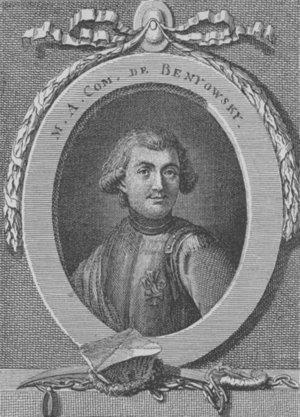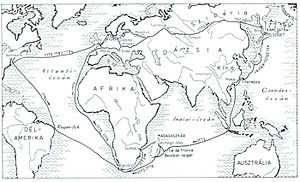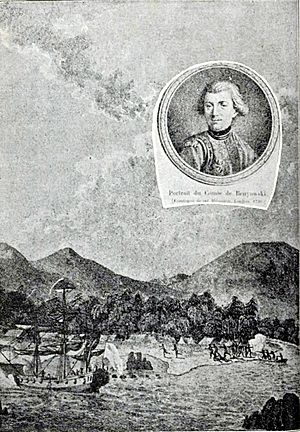Maurice Benyovszky facts for kids
Quick facts for kids
Maurice Benyovszky
|
|
|---|---|

Portrait of Benyovszky
|
|
| Born | 20 September 1746 |
| Died | 24 May 1786 (aged 39) Ambohitralanana, Madagascar
|
| Citizenship | Hungarian |
| Children | Samuel, Charles, Roza and Zsofia |
| Parents |
|
| Awards | Order of Saint Louis |
Maurice Benyovszky (born September 20, 1746 – died May 24, 1786) was a famous military officer, explorer, and writer from the Kingdom of Hungary. He called himself both Hungarian and Polish. Today, he is seen as a national hero in Hungary, Poland, and Slovakia.
Benyovszky grew up in Verbó, which is now Vrbové in Slovakia. In 1769, he was fighting for Poland when Russian forces captured him. They sent him far away to Kamchatka in Siberia. But Benyovszky was clever and managed to escape! He traveled all the way back to Europe, passing through places like Macau and Mauritius.
In 1773, he made a deal with the French government. He planned to set up a trading post on the island of Madagascar. This was a very challenging project. The climate was tough, the land was difficult, and he faced problems with the local Sakalava people. Because of these issues, he left the trading post in 1776.
Benyovszky then returned to Europe and joined the Austrian Army. He fought in a war called the War of the Bavarian Succession. After some other adventures, he traveled to America. He found people there who would help fund a second trip to Madagascar. However, the French governor of Mauritius sent soldiers to stop him. Benyovszky was killed in May 1786 during this conflict.
In 1790, a book about his adventures was published. It was called [Memoirs and Travels of Mauritius Augustus Count de Benyowsky, Volume 1] and [Volume 2]. This book became very popular, even though many of the stories in it were made up.
Contents
Early Life and Family
Maurice Benyovszky was born on September 20, 1746, in Verbó. This town is now called Vrbové and is in Slovakia. He was baptized with several names, including Mattheus Mauritius Michal Franciscus Seraphinus.
His father, Sámuel Benyovszky, was from a region in Hungary called Turóc County. He was said to be a colonel in the Austrian Army's Hussars. Maurice's mother, Rozália Révay, came from a noble Hungarian family. Her father was a baron.
Maurice was the oldest of four children born to Sámuel and Rozália. He had a sister named Márta and two brothers, Ferenc and Emánuel. Both of his brothers also became soldiers. Maurice also had three step-sisters and one step-brother from his mother's first marriage.
Maurice spent his childhood at the family mansion in Verbó. He studied at the Piarist College in Szentgyörgy (now Svätý Jur) from 1759 to 1760. Sadly, both of his parents died in 1760. After their deaths, there was a legal fight over the family home and property.
Marriage and Early Adventures
In 1765, Benyovszky took over his mother's property in Hrusó. This property was legally owned by one of his step-brothers-in-law. Because of this, his mother's family filed a criminal complaint against him. He was called to court in Nyitra (now Nitra). Before the trial ended, Benyovszky escaped to Poland. He went to join his uncle, Jan Tibor Benyowski, who was a Polish nobleman. Leaving the country was against the law for him.
In July 1768, he was arrested in Szepesszombat (now Spišská Sobota). He was trying to organize a militia for the Bar Confederation. This group was fighting against the Polish king. He was briefly held in Stará Ľubovňa castle. Around this time, he married Anna Zusanna Hönsch. She was the daughter of a butcher. Their first child, Samuel, was born in December 1768.
Maurice and Anna later had three more children: Charles, Roza, and Zsofia.
Prisoner in Siberia
In July 1768, Benyovszky went to Poland to join the Bar Confederation. This group was rebelling against the Polish king, who was supported by Russia. In April 1769, Russian forces captured him near Ternopil. He was imprisoned in several towns, including Polonne, Kiev, and Kazan.
He tried to escape from Kazan and made it to Saint Petersburg. But he was caught again in November. The Russians then sent him as a prisoner to the far east of Siberia. He traveled with other prisoners and exiles, including a Swede named August Winbladh. In September 1770, he finally reached Bolsheretsk, which was the main town in Kamchatka at the time.
Escape from Kamchatka
Over the next few months, Benyovszky and other prisoners planned a daring escape. They were joined by other people living in Kamchatka who were unhappy with their situation. In early May, their group started an armed uprising. They took control of the garrison in Bolsheretsk. During the fight, the commander, Grigorii Nilov, was killed.
They seized a supply ship called St Peter and St Paul. They loaded it with furs and food. On May 23, the ship sailed away from the Bolsha River, heading south. Benyovszky's own book says they sailed north and east, visiting places like Bering Island and Alaska. However, other accounts of the journey do not mention this long route. It seems unlikely they could have traveled so far in the time they had.
The ship first landed at Simushir in the Kuril Islands. They stayed there for about ten days to bake bread and check their supplies. They left a sailor named Gerasim Izmailov and two others on the island. Izmailov later became an explorer and trader.
Their next stop was in Japan, on the island of Shikoku. They rested there in July. They also traded with villagers, even though Japanese rules did not allow this. At the end of July, they landed on Amami-Oshima in the Ryükyü islands and traded successfully again. In late August, they arrived on the island of Formosa (now Taiwan). Three of the travelers were killed in a fight with local islanders. They then sailed to Dongshan Island in China. Finally, they reached Macau on September 22, 1771.
Soon after arriving in Macau, 15 of the travelers died, likely from not having enough good food. Benyovszky sold the ship and all the furs they had brought from Kamchatka. He then arranged for passage back to Europe. In January 1772, two French ships took the survivors away from Macau. Some stopped in Mauritius, some died on the way, and 26 people landed in the French port of Lorient in July.
First Trip to Madagascar
Benyovszky quickly got a passport to enter France and went to Paris. He spent months trying to convince French officials to fund a trading trip. He wanted to go to one of the places he claimed to have visited. Eventually, he persuaded the French Foreign Minister and Navy Secretary to fund an expedition. Benyovszky and a group of "Benyovszky Volunteers" would set up a French colony on Madagascar.
This expedition arrived in Madagascar in November 1773. By March 1774, they had set up a trading post at Antongil on the east coast. They tried to trade with the islanders for cattle and supplies. However, things did not go well. Another explorer, Kerguelen, arrived later and found that the Madagascans said Benyovszky was at war with them. This made it hard to get supplies. A ship that visited in July 1774 reported that 180 of the original 237 volunteers had died from sickness. Many officers also died.
Benyovszky's book claims that his son Charles was born and died in Madagascar in 1774. However, this is not confirmed by other sources.
Despite these problems, Benyovszky sent positive reports back to Paris. He asked for more money, supplies, and people. Meanwhile, French officials and traders on Mauritius complained to Paris. They said Benyovszky was causing problems for their own trade with Madagascar. In September 1776, Paris sent inspectors to see what Benyovszky had achieved. Their report was very critical. They found little evidence of the roads, hospitals, or trading posts Benyovszky had boasted about.
Benyovszky's own journal suggests he had great success against the local people. He even claimed they made him their supreme chief and King (Ampansacabe). But this does not match his own reports of constant troubles and small wars. In December 1776, Benyovszky left Madagascar. The few remaining "Benyovszky Volunteers" were disbanded in May 1778. The trading post was eventually closed by the French government in June 1779.
Adventures in Europe and America
After leaving Madagascar, Benyovszky returned to France in April 1777. He received a medal (Order of St Louis) and a lot of money in back-pay. He tried to get more money for a new plan for Madagascar, but his idea was rejected. He then asked Empress Maria Theresa of Austria for a pardon. He had fled Hungary for Poland in 1768. He went to Hungary and received the title of "Count" in 1778. He had been using this title for years without actually having it.
In July 1778, he joined the Austrian forces fighting in the War of the Bavarian Succession. His brother Emanuel was also fighting in this war. In early 1780, Benyovszky planned to develop the port of Fiume (now Rijeka) in Hungary. He worked on this project until the end of 1781, but he left it with many debts.
He then traveled to the United States. With a recommendation from Benjamin Franklin, whom he had met in Paris, he tried to convince George Washington to fund a militia. Benyovszky wanted to lead this militia in the American War of Independence. His brother Ferenc was also in America, fighting as a mercenary. Washington was not convinced.
Benyovszky returned to Europe, arriving in Britain in late 1783. He proposed a colony on Madagascar to the British government, but they also turned him down. Instead, he persuaded Jean Hyacinthe de Magellan of the Royal Society of London to fund an independent expedition. In return, Magellan got the rights to publish Benyovszky's memoirs. Benyovszky also got a document from Emperor Joseph II of Austria. This document gave him Austrian protection for exploring and governing Madagascar.
Second Trip to Madagascar and Death
In April 1784, Benyovszky and some trading partners sailed to America. They made a deal with two traders from Baltimore for money in exchange for a regular supply of enslaved people. In October of that year, the ship Intrepid sailed for Madagascar. It arrived near Cap St Sebastien in the north-west of the island in June 1785.
Here, the expedition faced attacks from the Sakalava people. Benyovszky and others were captured and were thought to be dead. The remaining members of the company sailed to Mozambique, sold the ship, and went their separate ways.
However, in January 1786, Benyovszky was reported to be alive. He was operating at Angonsty, near modern-day Ambohitralanana. The French governor of Mauritius, François de Souillac, was worried about Benyovszky disrupting trade again. He sent a small military force to Madagascar to deal with him. On May 23 or 24, 1786, Benyovszky was ambushed and killed by these troops. He was buried at his camp.
Interestingly, a newspaper in Warsaw reported in December 1787 that "the famous Hungarian Baron Beniowski, who was said so many times to have died," was in Vienna, having come from Istanbul. This suggests some mystery around his final fate.
Legacy and Influence
Much of what Benyovszky claimed to have done in Poland, Kamchatka, Japan, Formosa, and Madagascar is hard to prove. His adventures did not leave a lasting mark on history in terms of war or exploration. His main legacy comes from his autobiography, Memoirs and Travels of Mauritius Augustus Count de Benyowsky. This book was published in two volumes in 1790.
Even when the book first came out, many people doubted his stories. But it was a huge publishing success! It has been translated into many languages, including German, Dutch, French, Swedish, Polish, Slovak, and Hungarian.
The part of his Memoirs about Kamchatka was turned into many popular plays and operas. These were performed across Europe and America. The famous Polish poet Juliusz Słowacki wrote a poem about him in 1841. More recently, films and television series have been made about his life. These include a Slovak-Hungarian TV series in 1975 called Vivát Benyovszky! and a Hungarian film in 2012, Benyovszky, the Rebel Count.
In Hungary, Slovakia, and Poland, he is still celebrated as an important national hero. There is a Hungarian-Madagascan Friendship organization that promotes the connections between Benyovszky and Madagascar. They organize meetings and have a website dedicated to his life.
The Polish writer Arkady Fiedler visited Madagascar in 1937. He wrote a popular travel book that gave a romanticized version of Benyovszky's story. Fiedler tried to find out if the people of Madagascar still remembered Benyovszky. His name did survive there. In recent years, a street in Antananarivo, the capital of Madagascar, was renamed 'Lalana Benyowski'.
Images for kids
See also
 In Spanish: Móric Benyovszky para niños
In Spanish: Móric Benyovszky para niños









